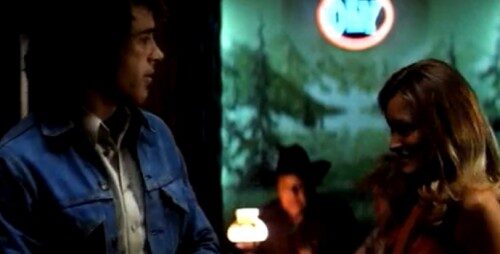Sartorial Analysis: Denim on Film – Part 3 | Clothes on Film
Third and final part of a sartorial analysis examining denim as symbolic recognition for character on film – focusing on The Parallax View (1974) starring Warren Beatty.
Action Man:
By the mid-1970s denim had been accepted as day wear for everyone, though still remained intrinsically associated with adolescent ‘drop out’ culture.
Warren Beatty was 37 at the time of shooting The Parallax View so could hardly be described as young; he looks just a little uncomfortable in a sky-blue western denim jacket and brown twill hip-huggers. Nonetheless the casual denim jacket remains a potent symbol of 1970s action hero. Mainstream acceptable yet scruffy, Beatty’s attire resists his character Joe Fredy’s profession as a determined journalist, but not his wayward personality.
A denim jacket in this era subliminally plants the seed of action in our mind. With his shaggy hair (that ten years previous would have been ridiculed as ‘deviant’ and no doubt contributes to his ribbing by a hic deputy) he struts around town almost embarrassed; like everyone is afraid of him because of the way he looks. His jacket is a clear nod to the frontier Wild West. It legitimises Beatty’s Fredy as a man capable of more than posing.
Political unrest and the fallout from sixties youth rebellion leant the public to now distrust authority figures and their typical uniform – the suit and tie. At this stage starchy James Bond was struggling to look young and fresh (in more ways than one). The era of the messy hero had dawned, and this situation would remain so until at least the mid-1990s.
Consider Keanu Reeves in 1993 action thriller Speed. He spends most of the film dressed in a plain white t-shirt, something that was thought of as underwear until the 1950s. Indiana Jones too only ever wears a suit (by choice) for lecturing or formality. The moment things get hairy, Temple of Doom (1984) being a perfect example of this; he throws on the famous grubby leather bomber and khakis. It’s his iconography. How we identify him. Indy’s silhouette is known the world over.
Chuck Norris was rarely seen without his own denim ‘Action Slacks’ in the 1980s. They were specially designed to stretch in the seat and groin for those all important high kicks and spontaneous squat thrusts. By the time Warren Beatty in The Parallax View soils his denim jacket by scrapping in a bar and then covering it with mud during a police chase, he has – in an example Chuck would eventually follow – made full use of the fabric’s inferred masculinity.
A few scenes on and Beatty swaps his dishevelled combo around for light blue denim jeans and a brown twill western jacket. Things are serious now; more white collar. Parallax do recruit potential murderers but they draw the line at layabouts wearing a denim jacket. Beatty’s denim is the epitome of distrust and free thinking radicalism. This is what sums up his character. Ultimately it is what seals his fate as a patsy.
So, did Warren Beatty help sales of the classic waist-length western denim jacket in any meaningful way? Doubtful. By 1974, denim was already the most popular fabric of the decade.
Levi were far and away the biggest selling denim clothing manufacturers at this time. Though up to denim’s true birth as leisurewear during the 1950s, Levi were overshadowed by the much larger Lee Mercantile Company (Lee jeans). Incidentally Beatty’s denims were not made by Levi – perhaps because such noticeable corporate branding would have seemed odd in light of the story’s premise?
Thirty five years on and denim on film still fails to ignite our sartorial choice. Think about how many modern movies dress their protagonists in jeans? Not that many when you consider the amount of people actually wearing jeans on a daily basis. This is probably because denim, on men in particular, just doesn’t look very good on camera.
© 2009, Chris Laverty.
Related Posts:



